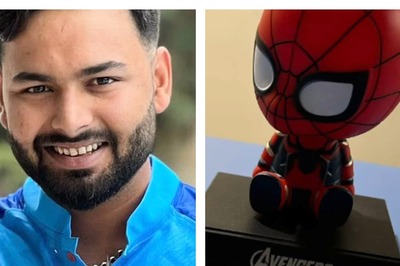
views
In a shocking incident, four children died on Wednesday morning after allegedly consuming “poisonous toffees” found outside their home in Uttar Pradesh. All victims were under the age of seven, and the police have booked their three neighbours and sent the toffees and wrappers for further examination, according to reports.
While this particular incident seems to have taken place due to personal enmity, the heinous crime takes one back to the urban legend of poisoned candies aimed at killing children celebrating the US festival of Halloween, and the criminal gang that led the Japanese police on a wild goose chase in the 1980s after stocking supermarkets with cyanide-filled candy.
News18 dives into these ‘candy crimes’ and their related urban myths and true stories in the world of crime and murder:
In the US, urban legends, bordering on hysteria, have plagued concerned parents since the 1970s. Fears that a blade, substances, or weed, hidden within the innocent-seeming candy distributed to their children during the tradition of trick and treating cause worry almost every year.
Halloween candy scares first appeared in 1970 when an op-ed published on October 28 in The New York Times suggested that strangers could use Halloween’s “trick-or-treat” tradition to poison children. The editorial referred to two unconfirmed incidents in upstate New York and posed a series of terrifying rhetorical questions. Judy Klemesrud, the author, wondered if that “plump red apple” from the “kindly old lady down the block…could have a razor blade hidden inside,” according to a report by the Conversation.
While most incidents used to alarm citizens were unconfirmed, a child died in Houston on October 31, 1974, and the death was caused by eating poisoned candy: the child’s father had poisoned his son by putting cyanide in a pixie stick to claim insurance money. He was dubbed the Candy Man or The Man Who Killed Halloween. (More on him, later.)
Newsweek magazine asserted in a 1975 article, despite the lack of evidence, that “over the past several years, several children have died and hundreds have narrowly escaped injury from razor blades, sewing needles, and shards of glass put into their goodies by adults,” the report further says. And by the 1980s, some communities had outlawed “trick-or-treating,” while hospitals in major cities offered to X-ray Halloween candy. Parent-teacher associations encouraged the use of fall festivals in place of Halloween, and on Long Island, a community group awarded prizes to children who stayed home on Halloween in 1982.
A comprehensive 1985 study of 30 years of alleged poisoning, on the other hand, found not a single confirmed incident of a child’s death or serious injury, according to the report.
The study’s lead author, sociology professor Joel Best of the University of Delaware, referred to it as an “urban legend.” The majority of reports of poisoned Halloween candy in print were editorials written by authoritative voices in politics and the media, rather than actual events. Police across the country, however, urged parents to accompany their children while trick-or-treating.
The report hypothesizes that those fears ‘might have been driven in part by the multitude of problems facing the United States at the time’ as the ‘the years from 1970 to 1975 were marked by cultural upheaval, both domestic and geopolitical’, such as the Watergate scandal.
But a very real story unfolded in Japan in the 1980s, when a cryptic group blackmailed the country’s largest candy companies for a year and a half. According to a detailed report on the horrifying incident by Atlas Obscura, the miscreants stocked supermarket shelves with chocolates laced with cyanide and detailed their exploits in elaborate, teasing letters that were published in national newspapers. But the ‘Mystery Man With 21 Faces’ as they came to be known, consistently thwarted the country’s police force. And no one knows who they were to this day.
‘Mystery Man/Monster With 21 Faces’
This group terrorised two Japanese candy companies, Ezaki Glico, and Morinaga, as well as other food companies, for a year and a half in the 1980s. They demanded ransom, kidnapped executives, and even smuggled cyanide-laced candy into stores. The Monster With 21 Faces had slashed company profits, terrified the Japanese, and frustrated police by the time their reign of terror came to an abrupt end.
One of Japan’s most popular candy companies was Ezaki Glico. It was thrust into the spotlight when two masked men broke into the home of its president Katsuhisa Ezaki that night. They bound Ezaki’s wife and daughter and dragged him naked from his bathtub around 9 p.m. They threw the candy executive into the trunk of a car and drove away into the night.
The kidnappers then demanded one billion yen (about $9 million today) and 220 pounds of gold bullion. Though Ezaki was able to flee before the company paid his ransom, the story was not over. After that, six cars were set on fire at a Glico factory, and the company was also sent a container of hydrochloric acid. The group then began sending threatening, mysterious letters, which were quickly published in newspapers.
“To the police fools. Are you all stupid? What the hell are you doing with all that manpower?” said their letter of April 8, 1984.
The Monster With 21 Faces claimed in mid-May that they had placed several packs of cyanide-laced Glico candy on store shelves. Panic gripped Japan as the group had not specified which candies were poisoned, and Glico recalled them all, leading to huge losses for the company. However, no evidence was found that The Monster with 21 Faces poisoned any Glico candy.
After declaring that they would lay off Glico, the Mystery Man reappeared sooner than expected. They called Morinaga, another long-standing candy company, in September and demanded $400,000. Morinaga refused to comply. As a result, on October 8, 1984, Japan’s newspapers received yet another letter:
“To moms throughout Japan:
In autumn, when appetites are strong, sweets are really delicious.
When you think sweets—no matter what you say—it’s Morinaga.
We’ve added some special flavor.
The flavor of potassium cyanide is a little bitter.
It won’t cause tooth decay, so buy the sweets for your kids.
We’ve attached a notice on these bitter sweets that they contain poison. We’ve put twenty boxes in stores from Hakata to Tokyo.”
Police swarmed grocery stores in and around Kyoto, Osaka, Kobe, and Tokyo, searching for poisoned candy. They discovered boxes of Morinaga Choco Balls and Angel Pies with warning labels that read, “Danger, contains poison.” If you eat this, you will perish. The enigmatic man with 21 faces.” This time, the candy tested positive for cyanide.
While no one died due to the candy, there was one life taken in the entire incident: Shoji Yamamoto, the head of the Shiga Prefecture police, doused himself in kerosene and set himself on fire in August 1985, blaming himself and his subordinates for failing to capture the Mystery Man during the stakeout.
The group sent their final letter five days later. It read, in part, “No-career Yamamoto died like a man.” “So we decided to give our condolence. We decided to forget about torturing food-making companies… We are bad guys. That means we’ve got more to do other than bullying companies. It’s fun to lead a bad man’s life. Mystery Man with 21 Faces,” said the letter, before they disappeared.
The Man Who Killed Halloween
Coming back to the United States, Ronald Clark O’Bryan also known as The Candy Man and The Man Who Killed Halloween, threw fuel into the poisoned candy rumours. He was convicted of killing his eight-year-old son on Halloween 1974 with a potassium cyanide-laced Pixy Stix collected during a trick-or-treat outing.
O’Bryan poisoned his son to collect life insurance proceeds to help alleviate his financial difficulties, as he was $100,000 in debt, according to reports. In an attempt to cover up his crime, O’Bryan also gave poisoned candy to his daughter and three other children; however, neither his daughter nor the other children ate the poisoned candy. In June 1975, he was convicted of capital murder and sentenced to death. In March 1984, he was executed by lethal injection.
Sweetmeat Seller Poisons 21 Dogs to Death in India
Back home, in 2021, a 24-year-old sweetmeat vendor was arrested for allegedly poisoning at least 20 stray dogs to death in Odisha’s Cuttack district as he was ‘fed up with their howling at night and the mess they used to make near his shop’, police had said. According to reports, the accused admitted to giving the dogs poisoned food.
Read all the Latest News India and Breaking News here




















Comments
0 comment